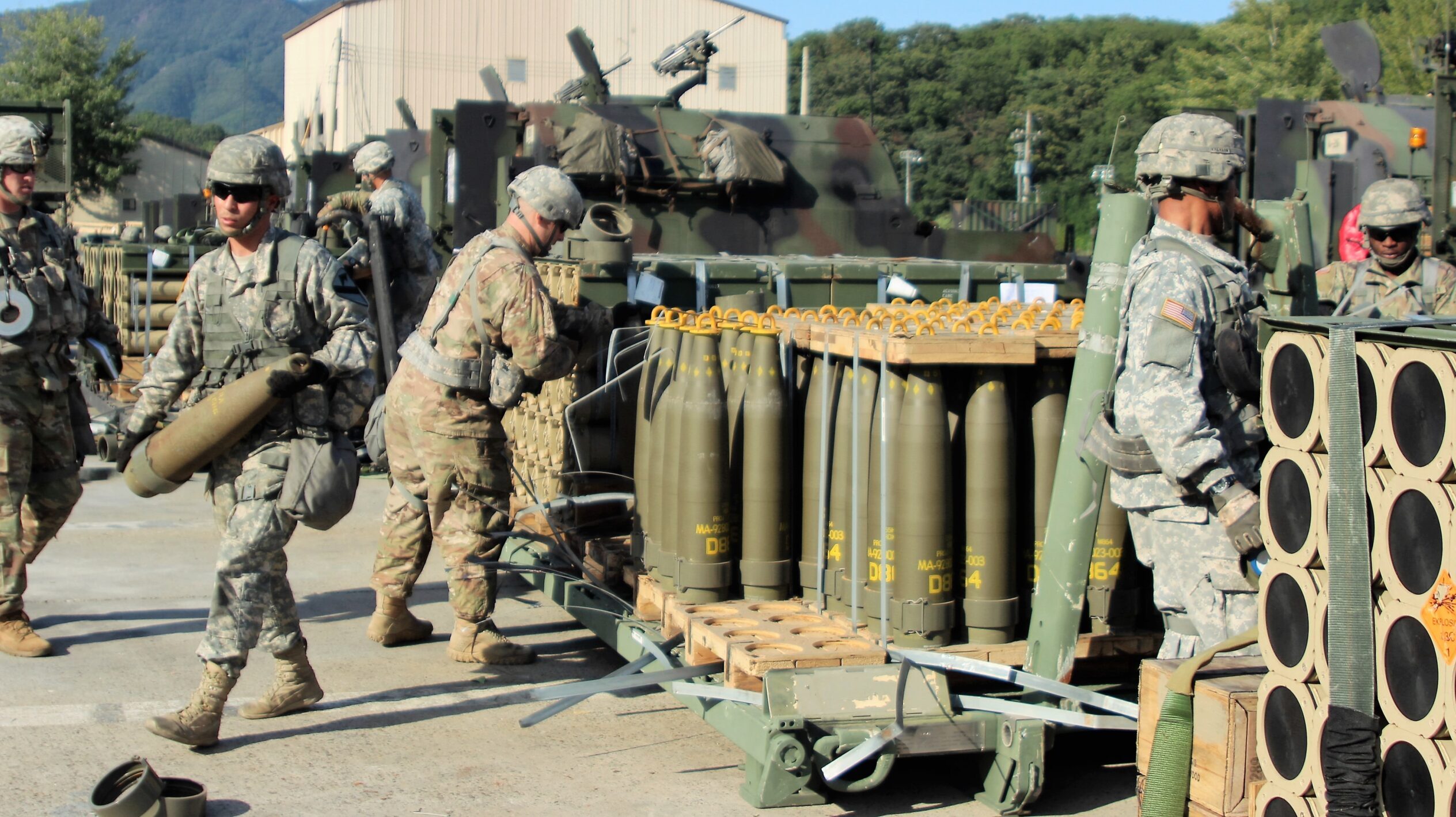
Soldiers from Alpha Battery, 1st Battalion, 82nd Field Artillery Regiment, 1st Armored Brigade Combat Team, 1st Cavalry Division, draw 155mm Base Burn Dual Purpose Improved Conventional Munition rounds, each weighing nearly 100 pounds, and carry into their vehicles during a load exercise directed by the 210th Field Artillery Brigade, 2nd Infantry Division. (U.S. Army photo/Lt. Gabriel Jenko)
This story was updated on 7/7/2023 at 4:20 pm with additional information from the White House’s National Security Advisor Jake Sullivan and Under Secretary of Defense for Policy Colin Kahl.
WASHINGTON and BELFAST — When NATO leaders gather in Vilnius, Lithuania next week, US President Joe Biden will bring along a plan to deliver controversial cluster munitions to Ukraine, the administration announced today. But not all allies and partners are on board, setting up a potential series of awkward interactions.
The decision, included as part of a new $800 million weapons package, comes at a time when Ukraine is firing roughly a thousand artillery rounds per day, and the US is still trying to ramp up production of those unitary rounds, Biden’s National Security Advisor Jake Sullivan announced at the White House.
“We’ve already seen substantial increases in production, but this process will continue to take time, and it will be critical to provide Ukraine with a bridge of supplies,” he told reporters. “While our domestic production is [ramping] up, we will not leave Ukraine defenseless at any point in this conflict period.”
Sullivan’s announcement today clears the way to deliver 155-mm dual-purpose improved conventional munitions (DPICMs) to Kyiv for its forces to fire from existing artillery launchers. Advocates of the move say the weapons could help mitigate an artillery round shortage, while providing an effective mode of attack against larger Russian formations. However, concerns about the weapons high failure rates and civilian risk make them hotly contested and banned in many countries including Germany, France, and the United Kingdom.
Ahead of the expected announcement, Reuters reported that German Foreign Minister Annalena Baerbock said she opposes sending cluster munitions to Ukraine, while NATO Secretary General Jens Stoltenberg asserted that the alliance as a whole will not weigh in.
“A number of allies have signed the convention but a number of allies have not signed the convention and it is for individual allies to make decisions on the delivery of weapons and military supplies to Ukraine,” Stoltenberg said. “So, this will be for governments to decide, not for NATO as an alliance.”
“We have to remember that this brutality is also reflected by the fact that everyday we see casualties from cluster munitions on both sides,” he later added. “Russia [uses] cluster munitions in their war of aggression to invade another country, while Ukraine is using them] to defend itself.”
US officials have not disclosed what level of buy-in they’ve received from other countries, especially those who have signed onto the treaty, but the White House seems to align with Stoltenberg’s “both sides” argument to help justify their position. Previewing the decision Breaking Defense on June 30, a US official said that since Ukraine and Russia are both using similar cluster munitions throughout the conflict, there is already a need to “clean up” the unexploded ordinances scattered about.
A Controversial Weapon, Sought By Ukraine
Like traditional artillery rounds, DPICMs are surface-to-surface weapons. However, the warheads are designed to explode and then disperse smaller munitions that themselves are designed to explode over a wider area.
“What DPICMs bring to a battlefield is anti-armor and anti-personnel capability,” Pentagon Press Secretary Brig. Gen. Pat Ryder told reporters Thursday. “So, essentially it can be either loaded with shape charges, which are armor penetrating, or they can be loaded with fragmentary munitions, which are anti-personnel.
“So clearly, a capability that would be useful in any type of offensive operations,” he added.
However, cluster munitions have a higher rate of failure and do not always explode. When that happens, civilians are at increased risk of death or injury if they accidentally stumble upon them and trigger an explosion.
That risk prompted 123 states to eventually sign onto the 2008 Convention on Cluster Munitions banning the weapon. The United States, Russia and Ukraine are among the countries that have not signed the treaty.
Past US leaders have also moved to halt the spread of those controversial weapons. For example, the Consolidated Appropriations Act of 2010 and 2019 limited Washington from transferring cluster munitions unless the submunitions failure rate is below 1 percent, a figure below the Pentagon’s assessment for the weapons bound for Ukraine.
Briefing reporters at the Pentagon Friday, Under Secretary of Defense for Policy Colin Kahl said Biden has the right to waive that requirement on national security grounds. Although he did not disclose which “newer” DPICM variants are bound for Ukraine, or how many, he said those weapons have a 2.35 percent failure rate or below, based on five tests occurring between 1998 and 2020. However, the public won’t get a chance to see details because they are classified.
“We’re confident in those numbers [and] I will also say how they’re used matters,” he said, noting that Kyiv has provided written assurances that it will not use the DPICM in “urban areas that are populated by civilians” and will track where they are used for future demining efforts.
Following the DPICM announcement, a trio of Republican lawmakers —House Foreign Affairs Committee Chairman Michael McCaul of Texas, Senate Foreign Relations Committee Ranking Member Jim Risch of Idaho, and Senate Armed Services Committee Ranking Member Roger Wicker of Mississippi — sent out a joint press release praising the decision and also highlighting what they want to see next.
“While no weapons system is a proverbial golden bullet, DPICMs will help fill a key gap for Ukraine’s military and will allow the Ukrainian armed forces to target and eliminate Russian forces more efficiently, including in fortified positions on the battlefield,” the three men wrote. “Providing DPICMs will also decrease the strain on America’s stockpile of unitary warheads. But the Biden Administration cannot stop here. It is critical they also send [Army Tactical Missile Systems] ATACMS.”






















